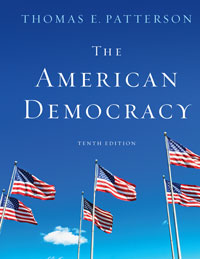 
The American Democracy, 10th Edition (Patterson)Chapter 2:
Constitutional Democracy: Promoting Liberty and Self GovernmentChapter Overview
This chapter describes how the principles of self-government and limited government are embodied in the Constitution and explains the tension between them. The chapter also indicates how these principles have been modified in practice in the course of American history. The major ideas in this chapter include:
- America during the colonial period developed traditions of limited government and self-government. These traditions were rooted in governing practices, political theory, and cultural values.
- The Constitution provides for limited government mainly by defining lawful powers and by dividing those powers among competing institutions. The Constitution, with its Bill of Rights, also prohibits government from infringing on individual rights. Judicial review is an additional safeguard.
- The Constitution in its original form provided for self-government mainly through indirect systems of election of representatives. The framers’ theory of self-government was based on the notion that political power must be separated from immediate popular influences if sound policies are to result.
- The idea of popular government—in which the majority’s desires have a more direct and immediate impact on governing officials—has gained strength since the nation’s beginning. Originally, the House of Representatives was the only institution subject to direct vote of the people. This mechanism has been extended to other institutions and, through primary elections, even to the nomination of candidates for public office.
 |  |
|

















